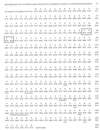Characterization and nucleotide sequence of CARB-6, a new carbenicillin-hydrolyzing beta-lactamase from Vibrio cholerae
- PMID: 9925522
- PMCID: PMC89067
- DOI: 10.1128/AAC.43.2.297
Characterization and nucleotide sequence of CARB-6, a new carbenicillin-hydrolyzing beta-lactamase from Vibrio cholerae
Abstract
A clinical strain of Vibrio cholerae non-O1 non-O139 isolated in France produced a new beta-lactamase with a pI of 5.35. The purified enzyme, with a molecular mass of 33,000 Da, was characterized. Its kinetic constants show it to be a carbenicillin-hydrolyzing enzyme comparable to the five previously reported CARB beta-lactamases and to SAR-1, another carbenicillin-hydrolyzing beta-lactamase that has a pI of 4.9 and that is produced by a V. cholerae strain from Tanzania. This beta-lactamase is designated CARB-6, and the gene for CARB-6 could not be transferred to Escherichia coli K-12 by conjugation. The nucleotide sequence of the structural gene was determined by direct sequencing of PCR-generated fragments from plasmid DNA with four pairs of primers covering the whole sequence of the reference CARB-3 gene. The gene encodes a 288-amino-acid protein that shares 94% homology with the CARB-1, CARB-2, and CARB-3 enzymes, 93% homology with the Proteus mirabilis N29 enzyme, and 86.5% homology with the CARB-4 enzyme. The sequence of CARB-6 differs from those of CARB-3, CARB-2, CARB-1, N29, and CARB-4 at 15, 16, 17, 19, and 37 amino acid positions, respectively. All these mutations are located in the C-terminal region of the sequence and at the surface of the molecule, according to the crystal structure of the Staphylococcus aureus PC-1 beta-lactamase.
Figures



Similar articles
-
CARB-9, a carbenicillinase encoded in the VCR region of Vibrio cholerae non-O1, non-O139 belongs to a family of cassette-encoded beta-lactamases.Antimicrob Agents Chemother. 2004 Oct;48(10):4042-6. doi: 10.1128/AAC.48.10.4042-4046.2004. Antimicrob Agents Chemother. 2004. PMID: 15388476 Free PMC article.
-
New carbenicillin-hydrolyzing beta-lactamase (CARB-7) from Vibrio cholerae non-O1, non-O139 strains encoded by the VCR region of the V. cholerae genome.Antimicrob Agents Chemother. 2002 Jul;46(7):2162-8. doi: 10.1128/AAC.46.7.2162-2168.2002. Antimicrob Agents Chemother. 2002. PMID: 12069969 Free PMC article.
-
Structure of CARB-4 and AER-1 carbenicillin-hydrolyzing beta-lactamases.Antimicrob Agents Chemother. 1998 Aug;42(8):1966-72. doi: 10.1128/AAC.42.8.1966. Antimicrob Agents Chemother. 1998. PMID: 9687391 Free PMC article.
-
Plasmid penicillin resistance in Vibrio cholerae: identification of new beta-lactamase SAR-1.Antimicrob Agents Chemother. 1986 Aug;30(2):245-7. doi: 10.1128/AAC.30.2.245. Antimicrob Agents Chemother. 1986. PMID: 3490216 Free PMC article.
-
Novel carbenicillin-hydrolyzing beta-lactamase (CARB-5) from Acinetobacter calcoaceticus var. anitratus.FEMS Microbiol Lett. 1989 May;50(1-2):45-50. doi: 10.1111/j.1574-6968.1989.tb03080.x. FEMS Microbiol Lett. 1989. PMID: 2786828
Cited by
-
Mobile class A β-lactamase gene bla GMA-1.Microbiol Spectr. 2024 Jan 11;12(1):e0258923. doi: 10.1128/spectrum.02589-23. Epub 2023 Dec 11. Microbiol Spectr. 2024. PMID: 38078722 Free PMC article.
-
Clinical and Environmental Vibrio cholerae Non-O1, Non-O139 Strains from Australia Have Similar Virulence and Antimicrobial Resistance Gene Profiles.Microbiol Spectr. 2023 Feb 14;11(1):e0263122. doi: 10.1128/spectrum.02631-22. Epub 2023 Jan 23. Microbiol Spectr. 2023. PMID: 36688638 Free PMC article.
-
CARB-9, a carbenicillinase encoded in the VCR region of Vibrio cholerae non-O1, non-O139 belongs to a family of cassette-encoded beta-lactamases.Antimicrob Agents Chemother. 2004 Oct;48(10):4042-6. doi: 10.1128/AAC.48.10.4042-4046.2004. Antimicrob Agents Chemother. 2004. PMID: 15388476 Free PMC article.
-
The Influence of Outer Membrane Protein on Ampicillin Resistance of Vibrio parahaemolyticus.Can J Infect Dis Med Microbiol. 2023 Jan 13;2023:8079091. doi: 10.1155/2023/8079091. eCollection 2023. Can J Infect Dis Med Microbiol. 2023. PMID: 36688009 Free PMC article.
-
Sensor histidine kinase is a β-lactam receptor and induces resistance to β-lactam antibiotics.Proc Natl Acad Sci U S A. 2016 Feb 9;113(6):1648-53. doi: 10.1073/pnas.1520300113. Epub 2016 Feb 1. Proc Natl Acad Sci U S A. 2016. PMID: 26831117 Free PMC article.
References
-
- Ambler R P. The structure of β-lactamases. Philos Trans R Soc London Biol. 1980;289:321–331. - PubMed
-
- Aubert G, Zambardi G, Zeni F, Paul G, Fournier J M, Oulahal N, Vermesch R. Abstract presented at the 7th International Congress for Infectious Diseases. 1996.
-
- Boissinot M, Levesque R C. Nucleotide sequence of the PSE-4 carbenicillinase gene and correlations with the Staphylococcus aureus PC-1 β-lactamase crystal structure. J Biol Chem. 1990;265:1225–1230. - PubMed
-
- Choury D, Aubert G, Siebert I, Assous M, Névot P, Paul G. Abstract presented at the 16th Interdisciplinary Meeting of Anti-Infectious Chemotherapy. 1996.
MeSH terms
Substances
Associated data
- Actions
LinkOut - more resources
Full Text Sources
Research Materials
Miscellaneous

